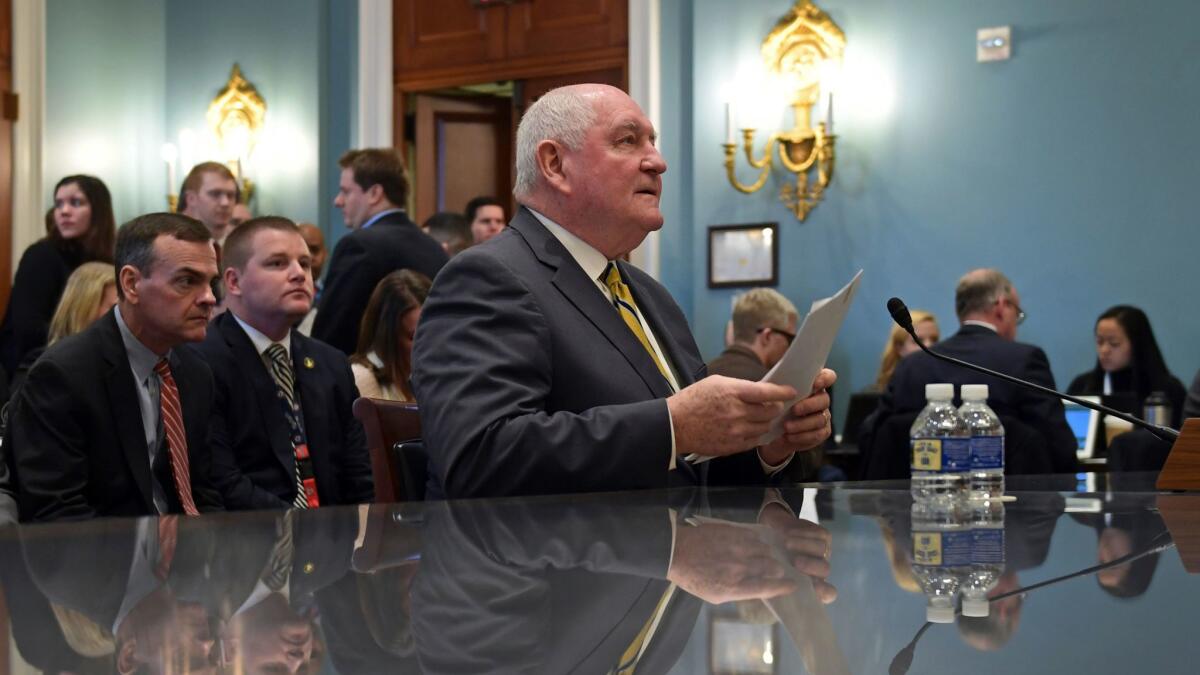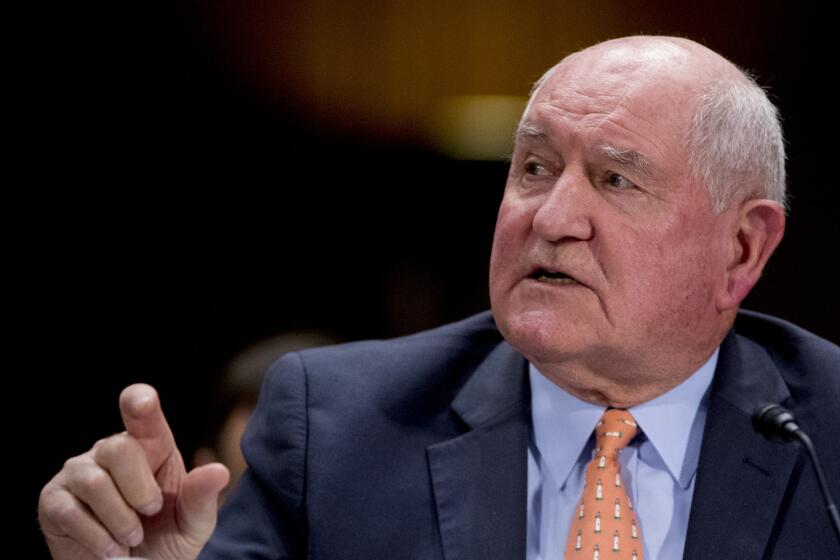Citing coronavirus, judge blocks Trump plan to take food stamps from 700,000 people

- Share via
Showing that at least some members of the federal government are doing their jobs, a federal judge late last week blocked a Trump administration rule change that would have thrown an estimated 700,000 low-income Americans off the food stamp rolls.
In doing so, Judge Beryl A. Howell of the District of Columbia delivered a stinging message about the necessity for federal agencies and courts, including even the Supreme Court, to keep an eye on facts on the ground — for example, the coronavirus crisis — before trying to push through or endorse policies that would harm vulnerable members of society.
“The current pandemic of coronavirus disease further highlights the connections between health and the SNAP program,” Howell wrote, referring to the Supplemental Nutrition Assistance Program.
The proposed changes would ... leave millions of Americans hungry and have profound and long-lasting consequences for their health.
— Aaron Richterman and Louise C. Ivers, New England Journal of Medicine
Low-wage workers are disproportionately unlikely to have paid sick leave or paid family leave, she observed. “The pandemic has put these already more vulnerable workers at higher risk of losing much-needed income, or even their jobs.”
We reported earlier that, amazingly, the Trump administration was planning to go ahead with a plan to apply more stringent standards to food stamp recipients starting April 1, just as the coronavirus crisis was beginning to throw middle- and low-income workers off the job.
The policy had been widely decried by poverty experts when it was first rolled out, but the Trump administration finalized it in December anyway. The rules at issue applied to childless adults, who under existing standards are limited to three months of benefits within any 36-month period unless they work at least 20 hours a week.
Trump’s latest attack on food stamp recipients will throw 700,000 off the rolls — and more attacks are coming.
The government has allowed states to waive the work requirement in any area with an unemployment rate of 2.5% or higher. Among the rule changes was one scheduled to go into effect in April, raising the unemployment threshold to 6%.
The Department of Agriculture further aimed to restrict states’ latitude to define the areas where they were measuring unemployment. Workforce advocates also objected to the USDA’s plan to use only the standard unemployment rate to measure need; the general rate, they argued, didn’t necessarily indicate the employment prospects of the target population.
As Howell noted, the government’s proposed rules generated more than 100,000 public comments, most of which were in opposition. That was remarkable, she wrote, because SNAP enrollees “wield little political or economic power.”
Despite the tsunami of negative reaction, the USDA actually finalized rules that “in some respects, were more draconian than those initially proposed.” The final package “radically rewrites the policies that have been in effect for 25 years,” without solid justification.
In all, 700,000 food stamp recipients were estimated to risk losing benefits once the rules went into effect. Nutrition experts Aaron Richterman and Louise C. Ivers reported in the New England Journal of Medicine that the consequences would be dire.
“The proposed changes would represent a retreat from our collective obligation to the most vulnerable members of society,” they wrote. “They would also leave millions of Americans hungry and have profound and long-lasting consequences for their health.”
Trump officials, including Agriculture Secretary Sonny Perdue, described this prospect as a good thing. The proposed changes were celebrated by conservative publications such as the Washington Examiner, which described them as part of a plan to close a “food stamp loophole.”
To save thousandths of a percent of the federal budget, Trump wants to throw half a million children off the school lunch program.
Judge Howell showed little patience for this position. “Especially now, as a global pandemic poses widespread health risks, guaranteeing that government officials at both the federal and state levels have flexibility to address the nutritional needs of residents and ensure their well-being through programs like SNAP, is essential,” she wrote.
Howell found that USDA “waved away ... commenters’ concerns and their supporting evidence in a few sentences of defective argument.”
As we’ve written before, the campaign to cut SNAP benefits has a long, discreditable history. In 2018, the then-GOP-controlled House tried to cut the SNAP budget by $17 billion over 10 years by tightening work rules (the program costs about $70 billion a year). Although Democrats were unanimously opposed, bizarrely the bill was killed by the House’s extreme right-wing caucus, which held it hostage to an immigration measure it favored.
Back in 2013, there was another attempt to cut food stamps. That effort to reduce the SNAP budget by $20 billion over 10 years deserves a place in the Capitol Hill Hall of Shame because it was heavily supported by numerous members of Congress who had slurped deeply from government crop supports and subsidies as farm owners.
Among them was Rep. Doug LaMalfa (R-Richvale), who carried on about the need to “retract just a little bit of the spending [on food stamps] ... to try to get this reform in place.” He called the $20-billion cut a “modest” change.
LaMalfa’s family farm had collected $5.1 million in government crop subsidies from 1995 through that year, according to the Environmental Working Group. At the time, 11% of the residents of Butte County, LaMalfa’s home county, were receiving SNAP benefits.
In all, more than 36 million mostly low-income Americans currently receive SNAP benefits, averaging less than $1.36 per person per meal.
Howell, an Obama appointee, concluded her ruling with a swipe at the Trump administration’s efforts to undercut judicial authority in cases such as these and even at the Supreme Court for bowing to the White House.
She was referring specifically to USDA’s backup argument that, were she to decide to block the food stamp changes, her injunction should apply only to the plaintiffs in the case — chiefly 19 states, the District of Columbia, and New York City —and not nationwide.
The USDA’s arguments were “off-the-wall,” Howell wrote. The potential harm created by the agency’s rule changes applied coast to coast, she observed.
She also dismissed the Trump administration’s assertion, echoed by Supreme Court Justices Neil Gorsuch and Clarence Thomas in a January ruling allowing the administration’s monstrous “public charge” rule to take effect, that nationwide court injunctions unduly burden the government and even create “chaos.”
“The harm to the federal government from having to enforce existing law, as it has for the last 25 years, in all 50 states is minimal,” Howell wrote, referring to the food stamps rules. “Any recent chaos stemming from nationwide injunctions is the product of an executive branch aggressive in pursuit of appeals and in advancing its present arguments in derogation of judicial power.
She added, “Perhaps that sort of power grab is to be expected from the executive branch. What is unexpected, and dangerous to the maintenance of our constitutional order, is that instead of fighting back, some courts have rolled over.”
More to Read
Inside the business of entertainment
The Wide Shot brings you news, analysis and insights on everything from streaming wars to production — and what it all means for the future.
You may occasionally receive promotional content from the Los Angeles Times.













